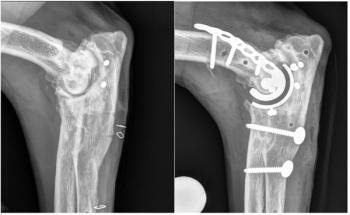
Improving Infection Rates After TPLO
A specialty referral hospital demonstrated that a stricter asepsis protocol makes a huge difference in postoperative infection rates.
Tibial plateau leveling osteotomy (TPLO) is one of the most common veterinary orthopedic surgeries, with current complication rates estimated at 19% to 28% of cases.
In a recent
Study Design
Dogs that had undergone TPLO surgery at a private veterinary referral center in North Carolina were identified retrospectively. Two periods were examined to compare a standard TPLO protocol (April 2006 to April 2008) with a modified protocol (January 2011 to December 2014).
RELATED:
- Joint Supplement Shows Promise in Managing Cranial Cruciate Ligament Rupture
- New Supplement Addresses Muscle Atrophy in Dogs
All TPLO procedures were performed by a board-certified veterinary surgeon in a dedicated orthopedic surgical suite, and patients received follow-up care for at least 18 months. Dogs were excluded from the study if they had a concurrent orthopedic procedure, previous stifle surgery, or systemic disease.
Standard procedure for all cases included the following: maximum occupancy of 3 to 4 personnel in the surgical suite; hanging-limb asepsis with alternating chlorhexidine gluconate solution and alcohol, followed by alternating chlorhexidine and sterile saline; medial surgical approach; postoperative analgesia and cefazolin administered until discharge the next morning; and no prophylactic antibiotics after discharge.
Major changes to the TPLO protocol in 2011 included:
- IV cefazolin dosing frequency was increased from every 120 minutes to every 90 minutes intraoperatively, and from every 6 to 8 hours to every 4 hours postoperatively until the next morning.
- Standard surgical drapes were replaced with an iodophore-impregnated antimicrobial incise drape applied directly to the surgical limb.
- Surgeons wore orthopedic surgical gloves instead of standard surgical gloves.
- Several types of TPLO plates were introduced.
- All incision layers were closed with antimicrobial suture, and skin staples were discontinued.
- A nonadherent dressing with mupirocin and adherent dressing retention sheet were worn until the morning after surgery.
The revised protocol also included postoperative radiographs, and all personnel were required to wear single-use gloves when handling patients. Finally, patients wore an Elizabethan collar at all times for 10 to 14 days postoperatively, rather than as needed.
With both protocols, perioperative inflammation or infection was treated empirically with oral antibiotics. If IAI was suspected due to persisting clinical signs such as lameness or pain, then the implant was removed and bacterial culture and sensitivity testing was performed.
Results
In total, 255 and 448 dogs underwent TPLO under the standard and revised protocols, respectively. Overall median age and weight were 5.5 years and 32.8 kg, respectively, and the most commonly represented breeds were mixed breed, Labrador retriever, and golden retriever.
The rate of postoperative infection decreased significantly from 7.4% to 0.9% of patients after TPLO protocols were revised, and the need for TPLO implant removal also decreased from 8.5% to 1.3% of cases. The most commonly isolated bacterium was coagulase-positive Staphylococcus spp.
Take-home Message
There were no significant associations between rate of IAI and dog age, sex, weight, affected limb, or reproductive status. Therefore, the investigators were confident that modifications to the TPLO protocol were responsible for the decreased infection rate.
Dr. Stilwell received her DVM from Auburn University, followed by a MS in fisheries and aquatic sciences and a PhD in veterinary medical sciences from the University of Florida. She provides freelance medical writing and aquatic veterinary consulting services through her business, Seastar Communications and Consulting.
Newsletter
From exam room tips to practice management insights, get trusted veterinary news delivered straight to your inbox—subscribe to dvm360.






